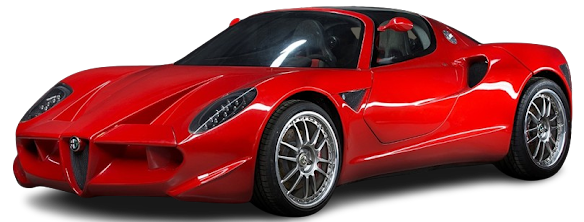Alfa Romeo Diva (2006)
The Alfa Romeo Diva Concept, revealed at the 2006 Geneva Motor Show, is a dramatic and experimental design study that fused Italian racing heritage with futuristic aesthetics. Developed in collaboration with the Istituto Europeo di Design (IED) and Fiat’s Centro Stile, the Diva was more than a styling exercise — it was a tribute to Alfa’s 1960s sports cars, reinterpreted through a radical modern lens. Compact, mid-engined, and visually bold, the Diva remains one of Alfa Romeo’s most unique and mysterious concepts of the 21st century.
History
By the mid-2000s, Alfa Romeo was in search of renewed design energy. The brand was known for its emotional styling and motorsport pedigree, but much of its recent lineup leaned toward front-wheel-drive sedans and hatchbacks. The Diva Concept was commissioned to reconnect Alfa Romeo with its racing soul, drawing inspiration from iconic models like the Tipo 33 Stradale, Giulia TZ, and 33/2 Daytona.
The project was a joint effort between IED Turin, Fiat Group’s Centro Stile, and engineering partner EnginTech. It also received input from Alfa Corse, Alfa Romeo’s competition division, ensuring the car was grounded in realistic proportions and motorsport influence.
While never intended for production, the Diva was a celebration of Alfa's design identity, showing what the brand could look like if it returned to its roots as a builder of radical, mid-engined sports cars.
Design Features
Visually, the Alfa Romeo Diva is compact, angular, and filled with racing-derived cues. Its low-slung silhouette, short overhangs, and wide stance reflect both form and function. The body is shaped to channel airflow efficiently, with sharp creases and dramatic cutaways defining its surface language.
The front end features a triangular Alfa grille flanked by slim LED headlights and large intakes. The fenders rise over the front wheels, giving the car an almost muscle-like presence. The rear is high and tight, with integrated vents, a race-style diffuser, and quad circular taillights — all elements nodding to 1960s Alfa race cars.
Doors open in a butterfly configuration, enhancing the car’s theatrical presence, while the roofline remains taut and minimal. The body is made from carbon fiber composites, keeping weight low and rigidity high.
Inside, the Diva is spartan and track-focused. The cabin features bucket seats, exposed materials, and a minimalist dashboard with analog gauges. Leather and aluminum dominate the interior, with a gear lever placed high on the console — emphasizing mechanical feel over digital distraction.
Specs
The Alfa Romeo Diva Concept is more than a static design — it was built on a real, functional platform. The chassis came from the Alfa Romeo 159, heavily modified for a mid-engine layout and sportier proportions.
Key technical specifications include:
-
3.2-liter V6 Busso engine, naturally aspirated
-
Estimated output: 260–280 horsepower
-
6-speed Selespeed sequential gearbox
-
Mid-engine, rear-wheel-drive configuration
-
Projected 0–100 km/h in under 5 seconds
-
Top speed: estimated 250 km/h (155 mph)
-
Carbon-fiber body over steel-aluminum structure
-
Curb weight: approximately 1,200–1,300 kg
Suspension geometry was revised from the 159 donor platform, with fully independent double wishbones and upgraded dampers for sharper dynamics. Braking was handled by vented discs with performance calipers — again borrowed and adapted from Alfa's production and racing experience.
Production Status
The Diva Concept remained a one-off, never intended for mass production or limited series. However, its creation signaled a design renaissance for Alfa Romeo. The car received wide acclaim at its Geneva debut and became a cult favorite among enthusiasts, collectors, and design scholars.
Though the Diva didn’t directly lead to a production model, its design cues — especially the aggressive surfaces, bold grille framing, and sculpted proportions — appeared later in Alfa Romeo 8C Competizione, 4C, and even the modern Giulia Quadrifoglio.
The concept still exists today and is part of Alfa Romeo’s historical collection, occasionally displayed at exhibitions and concours events.



Comments
Post a Comment